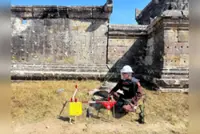Too close for comfort: Aerial view of the Batu Caves limestone karst hill in Gombak, Selangor, showing development has reached its foothills without adequate buffer zone to protect the fragile cliffs. — GLENN GUAN/The Star
Tourism Selangor navigates rocky terrain while juggling between heritage and development
SELANGOR’s dream of seeking international recognition for the Gombak-Hulu Langat Geopark (GHL Geopark), a natural wonder which has already achieved national status, is facing a slight delay.
Citing the need for additional preparation time, Tourism Selangor chief executive officer Azrul Shah Mohamad said his team was working towards submitting the application for the prestigious Unesco Global Geopark label within four years.
“While our initial target was 2027, we have extended it to 2028,” he explained.
ALSO READ: Encroachment damaging fossils, rare species in Batu Caves, researchers warn
“The intricate process and comprehensive documentation required for compiling the dossier necessitated the delay.”
The GHL Geopark joins the ranks of 10 other national geoparks, including Jerai Geopark in Kedah, Kinta Valley and Lenggong Geopark in Perak, Labuan Geopark in the Federal Territory of Labuan, Sarawak Delta Geopark in Sarawak, Stong Geopark in Kelantan, and Kenyir Geopark in Terengganu.
Malaysia currently boasts two global geoparks with Unesco status: Langkawi Unesco Global Geopark and Kinabalu Unesco Global Geopark.
A geopark is a single, unified geographical area where geological heritage sites are managed as part of a holistic concept of protection, education and sustainable development, encompassing tourism and conservation.
“The GHL Geopark is all that and more; it encompasses the Gombak district and parts of Hulu Langat, falling under the jurisdiction of Selayang Municipal Council (MPS) and Ampang Jaya Municipal Council (MPAJ),” said Azrul Shah.
He added that the area encompassed more than 112,955ha.
The Federal Government recognised GHL Geopark as a national geopark on Nov 14, 2022.
ALSO READ: Food court in Gombak cave stirs up concerns (Poll Inside)
On Nov 10, 2023, Selangor Mentri Besar Datuk Seri Amirudin Shari, when tabling the 2024 Budget, said the state would allocate RM2mil to facilitate the GHL Geopark’s recognition as a Unesco Global Geopark.
“For a geopark to be globally recognised, there should be elements of ecology, geology, archaeology, history and culture, and all these elements must be strengthened through comprehensive and effective management and control.
“For success, it is crucial that the community appreciates the area’s economic and cultural value. This is particularly true for geological heritage and involvement in tourism activities,” said Azrul Shah.
ALSO READ: Rock formations in cave not damaged, says eatery operator
He said it was essential for their Unesco aspiration, as the organisation advocated for the bottom-up approach of combining conservation with sustainable development while involving local communities.
“Each state has its own geopark, and in order to qualify for National Geopark status, the National Geopark Evaluation Committee will review, assess, and evaluate.”
Selangor’s tourism brochures highlight the GHL ridge as having an estimated age of 82 million years, originating as a burrow formed within the earth but later exposed to the surface during the basin-filling process in the Paleocene-Holocene period due to extensive weathering.
The harsh mineral properties of quartz compared to granite rocks accentuate the shape of the ridge.
This geosite is the longest (exposed) quartz ridge in South-East Asia, spanning 14km.
“Our geopark has a rich and diverse history and attractions, including hot springs, waterfalls, forests, wildlife and a whole lot of other gems that sadly, many people don’t know about,” said Azrul Shah.
“When people talk about visiting a geopark, they think of Langkawi, but our geosites are equally fascinating,” he said, adding that GHL has 31 geosites in total, but the state is focused on developing and promoting 20 first.
“Out of those, 13 are tourism sites like Batu Caves, Kanching River Falls, Selayang Hot Springs, and the Batu Arang coal city.
“We are promoting all these sites, and because GHL is an urban geosite, there are issues and challenges that require our attention, especially since these sites are located in townships right next to residential and business areas that come under multiple city councils and agencies.
“The challenge is to be able to combine both conservation and sustainable economic development with the residents and local councils, and to strike that balance between scientific and natural resource preservation and the development of tourism,” he elaborated.
Push for Unesco status
On the criteria for selection of Unesco Global Geoparks, Azrul Shah said the focus was on global heritage with an emphasis on the relationship between geological features and local communities.
According to the Unesco website, a Unesco Global Geopark has multiple aims which include capacity building, improving governance, and promotion.
Some of the better-known ones in the region are Bohol Island Unesco Global Geopark in the Philippines, Rinjani-Lombok and Toba Caldera Unesco Global Geopark in Indonesia as well as Dak Nong Unesco Global Geopark in Vietnam.
Geoparks serve local communities by combining the conservation of their significant geological heritage with public outreach and a sustainable approach to development.
A Unesco Global Geopark is not a formal legislative designation, although the defining geological heritage sites within a Unesco Global Geopark must be protected under indigenous, local, regional or national legislation as appropriate.
Local, state or federal management authorities ensure appropriate site protection measures within individual site management plans, in cooperation with the relevant agencies, to guarantee effective conservation and protection and provide necessary monitoring and maintenance of the proposed area.
Azrul Shah said that while Tourism Selangor was actively promoting and preparing the site for Unesco recognition, they were working with the Mineral and Geoscience Department to find ways to retain and sustain the geopark area.
However, he conceded that there were challenges with various stakeholders.
“We have to raise awareness of the geological heritage, landscapes and fossils, and to bridge that heritage to sustainable development and local communities and maintaining that balance,” he said, adding that the state was collaborating with geologists, town planners as well as local communities in the area to make it happen.
“We have appointed local experts who are familiar with the area’s history; we are empowering them to inculcate the sense of belonging and love for the area, and we have done this in Batu Arang with the Batu Arang Heritage Association.
“And we have also involved schools and universities within the geopark area to become Geo-School ambassadors whereby students are taught about the importance of geoparks.”
So far three schools, SK Batu Arang, SK Dusun Tua, and SK Melawati 2 have been appointed as geopark ambassadors.
Insufficient understanding
However, Azrul Shah said that despite some tourist attractions being located within the geopark area, public awareness remained lacking.
“One of the major challenges is the lack of awareness and conservation efforts.
“There is insufficient public understanding of the importance of geological heritage, and inadequate conservation measures have been taken for most of the geoparks in Malaysia, exacerbated by rapid infrastructure development,” he noted.
To address this issue, he said Tourism Selangor was working with the Mineral and Geoscience Department to seek professional advice on how to preserve and sustain the geopark area.
Another challenge they face is one arising from conflicts among different stakeholders, as some geopark areas are privately- owned by communities, state-owned, or under the jurisdiction of the State Forestry Department.
Through Tourism Selangor’s efforts, Azrul Shah said attempts were made to bring together all stakeholders to ensure the preservation of selected geosites and the long-term conservation of geological heritage.
“We have to encourage development within the geopark area with a comprehensive sustainability approach and ensuring adherence to the GHL Geopark management plan guidelines and the National Geopark Development Plan 2030 by all parties involved.”
He hopes that once Unesco recognition is achieved, it will facilitate the implementation and promotion of rules and regulations to the public.
“We need to start educating our children now as the future generation who will be the caretakers of these national treasures.
“Because at the end of the day, our biggest threat is still posed by us humans,” he added.











